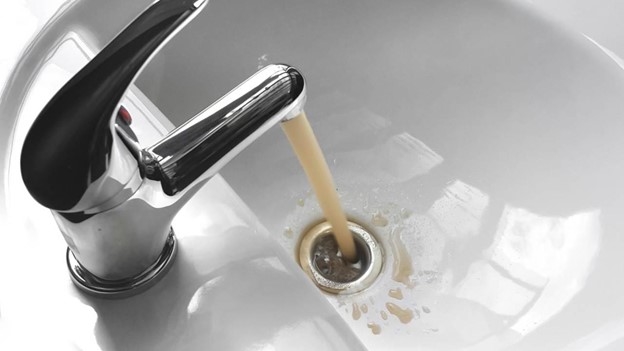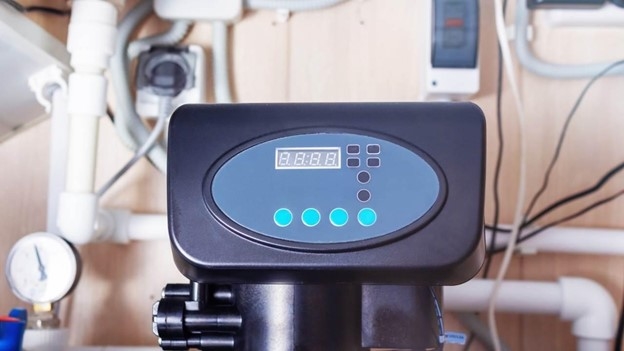Most of us take it for granted that the water we drink from the kitchen tap is clean and safe to drink.
But what about if you turn on the tap and the water from your good system looks dirty? If it’s brown it could be because of sediment, iron, manganese, or tannins.

The Causes & Dangers of Brown Well Water
There are several reasons that well water may be running brown. If you have iron, manganese, sediment, or silt in your water, it can cause you to get rusty-colored water.
Iron
Iron is the most common reason why well water is brown. It comes from rocks and soil surrounding the aquifer where your wells draw their water supply.
The dangers of too much iron in your water are that it can stain fixtures and surfaces, especially when you use hot water.
High levels of iron in the water can corrode metal pipes and damage appliances such as dishwashers and washing machines.
Health-wise, if you drink water containing a high level of iron, it can cause stomach cramps and nausea.
Tannins
Tannins are another common pollutant that can enter your well water and make it look brown.
Tannins occur naturally in leaves and other organic materials, such as peat moss, which can seep into your groundwater and cause you to get the brown color, and the bad taste and odor of tannin-rich water.
Tannins can cause serious stains and discoloration of fixtures, laundry, and bathtubs. Elevated levels of tannin can also decrease water flow by as much as 30%. It can leave a bitter taste to drinking water and may be harmful to your health.
Manganese
Manganese is a naturally occurring mineral that can cause your well water to turn brown. It can also form if the water has been exposed to air, an action that could lead to pipes rusting and forming manganese residue deposits.
It isn’t poisonous but it can cause black stains on sinks, tubs, showers, and fixtures.
When the water contains high levels of manganese it can give drinking water a bad taste and smell. Too much manganese in your water may also cause stomach cramps, nausea, and diarrhea.
Read Also:
Silt or Sediment
Silt and sediment usually come from erosion around lakes, ponds, rivers, and streams. High levels of sediment in the water can cause discoloration and can clog filters and piping requiring parts to be replaced.
The main concern with silt and sediment in your drinking supply is the impact it could have on health. But it can also cause clogging in appliances such as dishwashers and hot water heaters.
Testing Your Well Water to Identify the Cause
You should test your well water if you suspect that it is running brown. The easiest way to do this is by using a home testing kit, which will allow you quickly get an idea of what’s causing the problem so you can get drinking water solutions in place.
Once you have identified the cause of the brown water in your well, you can start looking for the best solution to get your supply clean again.
Some options could include a drinking water system that includes an iron filter or a water softener. You could also have a sediment filter, or a reverse osmosis system installed, depending on what your budget is and how bad the problem is.
How to Choose the Best Filter or Treatment Solution
Some people choose not to treat their well water at all, instead opting to boil it for between five and 10 minutes before drinking.
This will usually solve any problems related to bacteria or parasites but may not be effective against minerals such as manganese and iron, which will still cause discoloration of your water.
For High Levels of Tannins
Consider a tannin filter which is similar to a water softener. They include two tanks: a smaller, sealed-top tank and a larger, open-topped tank.
The filter material is kept in the small tank. Brine, which is saltwater, is stored in the larger tank.
Your water will run through a bed of beads, which will take in the tannins. Periodically the system needs to be flushed or regenerated to wash the tannins out of the media and into your drain.
For High Iron Levels
There are three types of iron, but it’s only ferric iron and organic iron that causes discolored water. Ferrous iron is also known as clear water iron, so this won’t be the cause of your brown water.
If you have high levels of ferric iron, then there are several types of iron filtration systems for well water that can help you.
For ferric iron, consider a chemical oxidation filter or a greensand filter. Chemical oxidation works by oxidizing the iron, which means it breaks down into smaller particles which can then easily be filtered out.
Another option is a greensand filter which is made of large grains of sand-like manganese dioxide mixed with greensand, a mineral containing iron and magnesium oxide. It works in a similar way to a tannin filter or a water softener and needs flushing regularly.
For High Manganese Levels
Both chemical oxidation and greensand filters (described above) are effective for removing manganese.
Air injection is another option for treating high levels of manganese. It works by forcing air into your water supply and oxidizing the manganese before it reaches your faucet.
For Silt and Sediment
If the problem of your brown discolored water turns out to be silt or sediment, you can buy a sediment filter.
Sediment filters are usually made of polypropylene and use fine-grade filtration media to trap any particles larger than five microns in size that may be making it into your water supply.
These are usually used as a pre-filter and help to protect more expensive filters and reverse osmosis units, which are further down your water stream.
Say Goodbye to Brown Water and Stains
If you’re experiencing brown water in your well, the first step is to test for a specific cause.
Whether it’s manganese, iron, silt, or sediment that is causing the problem, knowing what’s causing your problem will help you choose the right solution for your needs.











